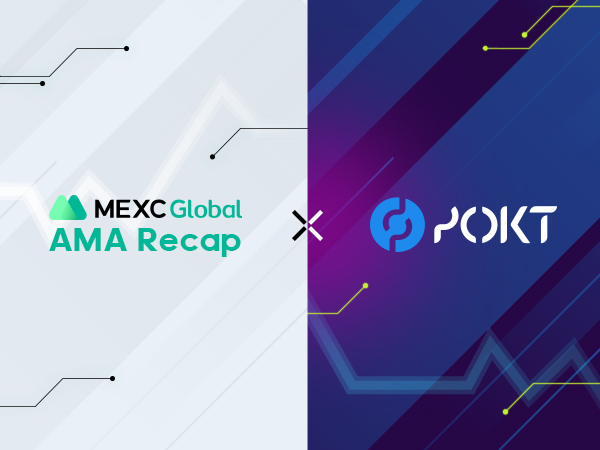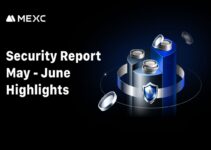In this Telegram AMA recap, you’ll find insights about the Pocket Network (POKT)project. In an event hosted by Miranda from MEXC, you will meet Michael O’Rourke from Pocket NetworkProject.

Introduction of Pocket Network AMA Member :
Hello everyone. My name is Michael O’Rourke, Co-Founder and CEO of Pocket Network. I am a self-taught iOS and Solidity developer who previously owned and operated a blockchain development agency before identifying the need for decentralized infrastructure in 2016 and beginning to build what is now Pocket Network. I was also on the ground level of Tampa Bay’s largest Bitcoin/Crypto meetup and consultancy, Blockspaces, with a focus on teaching developers Solidity.
Questions from community to Pocket Network:
Question 1:
Miranda: What is Pocket Network? Can you share with us more in detail?
Michael: Pocket Network is a decentralized blockchain API built for Web3 apps, relaying data to and from any blockchain through a network of thousands of nodes. If you are familiar with Infura or Alchemy, you can think of Pocket Network as a decentralized multi-chain alternative.
Since our mainnet launch in July 2020, we have served billions of “relays” across our customers of 40+ blockchain mainnets & testnets. We are trusted by some of the most used tools/projects in the Ethereum ecosystem, such as EthersJs, Scaffold.Eth and MyCrypto, as well as by Blockchain Foundations themselves such as Harmony, IoTex and others.
And Integrations with Algorand, Solona, Avalanche and a lot of other well-known protocols and DApps.
Question 2:
Miranda: Thanks Michael, next can you tell us what are some of the real-world problems/ pain points that Pocket aims to solve?
Michael: Pocket Network was founded after identifying a centralized bottleneck in the DApp development tech stack, where Ethereum was relying heavily on a single service SaaS provider to provide accurate API data. Like a lot of crypto projects they are decentralized at the protocol level but rely heavily on centralized service providers to fetch data. Pocket solves for full decentralization meaning the software and how it is hosted and DApps administration also becomes decentralized. 100% uptime!
We are already a key part of the multi-chain world servicing much of the crypto industry and growing fast.
Question 3:
Miranda: so compared to other similar projects in the industry, what are Pocket’s unique selling points?
Michael: For starters, these other “decentralized solutions” are not considered competitors. Instead, consider them as complementary parts of the decentralized web3 developer stack. Each of these application-specific middleware protocols or “infrastructure legos” address a different layer of this stack: the Graph protocol is at the indexing layer, Arweave is at the storage layer, Akash is at the cloud layer, Livepeer is at the Video Transcoding layer, and Pocket is at the RPC layer.
It’d be more appropriate to compare these decentralized solutions against their centralized counterparts. In this case, let’s refocus the conversation back to Pocket Network.
In the old paradigm, developers would go to Infura for network bandwidth. For example, for 1M requests per day Infura charges 225 USD (+250 USD for archival) per month to developers.
With Pocket Network there are no more monthly sunk costs (i.e. subscription IaaS fees). Instead, developers stake POKT – Pocket Network’s native cryptocurrency – once up-front on behalf of their application(s) for the equivalent network bandwidth that is accessible and consumable for the lifetime of that stake. At the moment, the relay per POKT ratio is 13.37 relays per POKT so it’d be an initial one-time (and recoupable) cost of 3116 POKT for the same 1M requests per day that Infura provides.
The longer an application stays staked and uses Pocket Network, the closer their costs approach zero. This economic concept is called near-zero marginal costs. After some time, the service basically becomes free.
It’s important to highlight that the developers can always unstake, then resell POKT on a secondary market to recoup their initial costs. Also, the Pocket DAO can push and pull economic levers such as the relay to POKT application rate at different stages of growth/maturity. This helps keep the decentralized RPC service (as a protocol) affordable to developers; and competitive against centralized RPC providers. For example, at launch, the relay to POKT application stake rate was 25k POKT for 1M requests per day then it was updated to 8k POKT for 1M requests per day and now 3.1k POKT for 1M requests per day.
By leveraging the tokenomics of these different middleware protocols, developers can actually expect to see massive savings without sacrificing the benefits that come naturally with decentralization.
Question 4:
Miranda: What about the roles of $POKT in Pocket Network? Would you tell us more about its tokenomics?
Michael: Pocket Network uses a native cryptocurrency (POKT) to create a permissionless, two-sided market between node providers who run full nodes and developers that want to query data from a blockchain for their application/service.
Pocket Network requires both developers and nodes to stake its native utility token, POKT, to participate in the network. Due to the unique incentives on each side of the market, staking differs between the parties.
On one side of the protocol App Developers stake POKT in order to gain access to an allotted amount of API calls (relays) in perpetuity. If they decide to leave the network, they can unstake and resell that POKT on an open market. This brings their costs to near 0 over time compared to a consistent (likely increasing) monthly bill over time.
This means that there is no sunk cost. POKT turns infrastructure into an asset
On the other side of the protocol, Node Runners stake POKT in order to participate in serving the network. Node Runners must provide quality of service to the blockchains networks they choose in order to be rewarded for their service.
Pocket Network’s tokenomics encourage node operators to horizontally scale their nodes in order to capture more opportunities to randomly get chosen to participate in work sessions to serve applications and earn POKT (for that work). It’s full-node incentivization at work!
Question 5:
Miranda: Are there any exciting news or updates with regards to Pocket that you would like to share with the users?
Michael: At a high level, here are a few things you can look forward to:
– More blockchains supported
– More partnerships with / adoption by applications and protocols
– wPOKT token
– POKT <> wPOKT token bridges
– Pocket Portal improvements
– Pocket 1.0 specification
We expect Pocket Network in the next year to process many billions of relays per day. Right now we are doing 2+ billion per week and still growing rapidly. This also translates into real revenue and accrued value for our holders.
Current research is aiming for Pocket Network to have the ability to support trillions to quadrillions of relays, across million+ nodes – there is no conceptual limit to Pocket Network, it just will take careful engineering to scale correctly. The future is exciting and we have all the right things in place.
Question 5:
Miranda: If you were to summarize your project in ONE word, what would it be? Why?
Michael: Undeniable
We expect that liquidity channels will open up as our protocol becomes more and more undeniable in terms of industry utility, where we are replacing middlemen with middleware and continue to eat up the inherent inefficiencies in the current way the crypto industry is supported by cloud computing and hosting providers. Being cheaper, faster, better is a winning formula that we will continue to execute and scale.
Free-asking Session to Pocket Network
Q1. Did you consider community feedback/requests during the creation of your product in order to expand on fresh ideas for your project? Many projects fail because the target audience and clients are not understood. So I’d like to know who your ideal consumer is for your product?
Michael:
We absolutely take feedback from users and the community involved in Pocket. For example, The Pocket DAO went through a 2-month governance process taking all the feedback from the community regarding the economics of the protocol. When it comes to the product itself, we have developers always giving feedback that we add into the portal itself
Q2. Are you a global project or a local project? At present, which market are you focused on, or is it focused on building and growing to gain customers, users and partners?
Michael:
We are a global project. We’ve got 40 employees in 11 countries with POKT holders across all major continents, with a big focus on the Americas, EU and Asia. Our focus has always been on driving dapp usage and will continue to be through investing in hackathons and bringing on new blockchains.
Q3. Too many projects promise magic but never release any working product or prove any revenue, Within a short/long time of release. Is your project also like this? If not can u tell us, What makes your project different from other projects?
Michael:
Pocket has been live since July 28th, 2020. We have always kept our heads down and built for the use case we felt was the most impactful for our users. We have always focused on getting the quality of service and user experience nailed before marketing to developers. Now that we’ve reached that moment, we are just now building out our marketing team.
Join MEXC and Start Trading Today!



